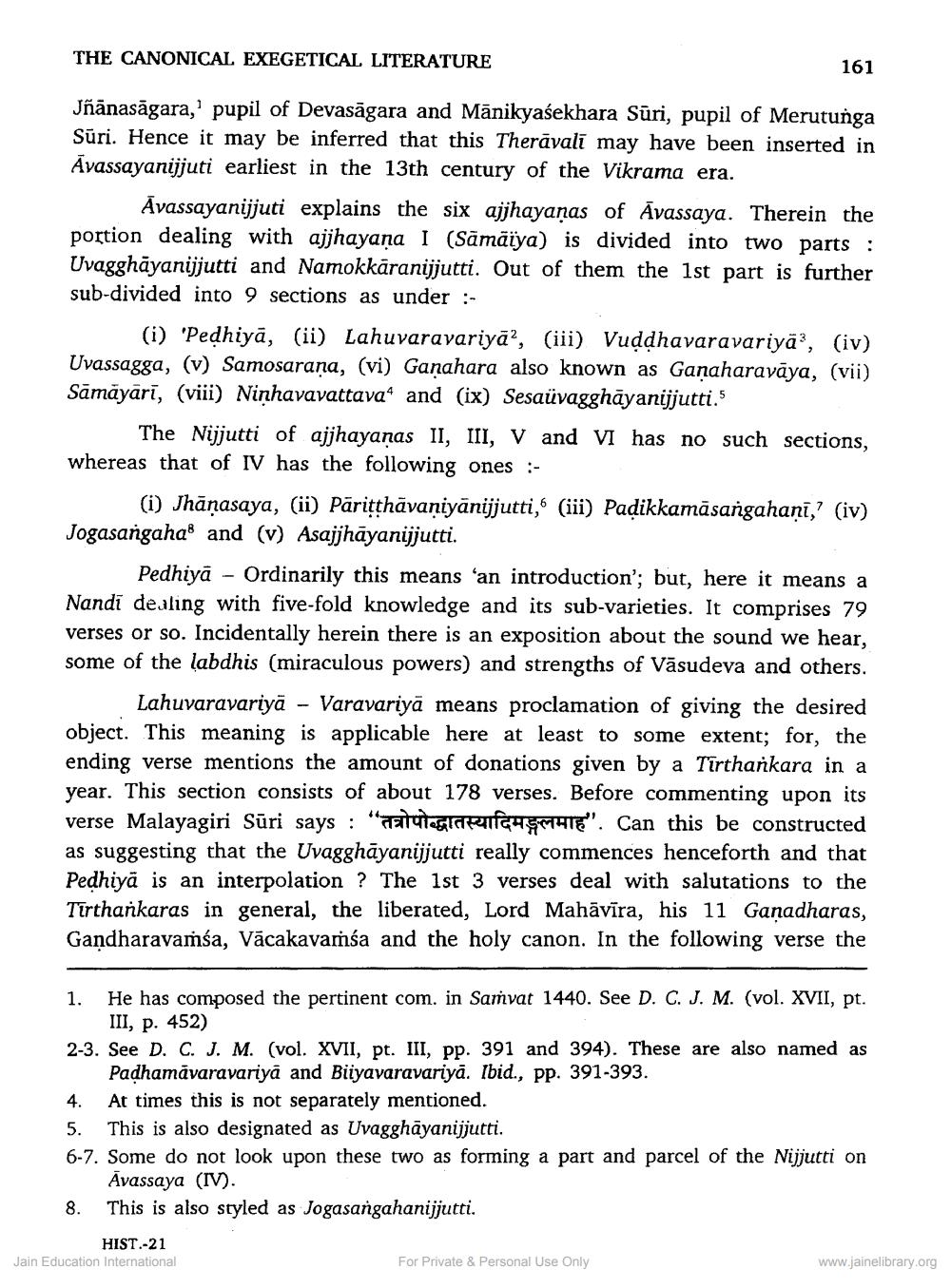________________
THE CANONICAL EXEGETICAL LITERATURE
161
jñānasāgara," pupil of Devasāgara and Mānikyasekhara Sūri, pupil of Merutunga Sūri. Hence it may be inferred that this Therāvali may have been inserted in Āvassayanijjuti earliest in the 13th century of the Vikrama era.
Āvassayanijjuti explains the six ajjhayaņas of Āvassaya. Therein the portion dealing with ajjhayana I (Sāmāïya) is divided into two parts: Uvagghāyanijjutti and Namokkāranijjutti. Out of them the 1st part is further sub-divided into 9 sections as under :
(i) 'Pedhiyā, (ii) Lahuvaravariya”, (iii) Vuddhavaravariya”, (iv) Uvassagga, (v) Samosarana, (vi) Ganahara also known as Ganaharavāya, (vii) Sāmāyāri, (viii) Ninhavavattava" and (ix) Sesaüvagghāyanijjutti.5
The Nijjutti of ajjhayanas II, III, V and Vi has no such sections, whereas that of IV has the following ones :
(i) Jhānasaya, (ii) Pāritthāvaniyānijjutti, (iii) Padikkamāsangahani, (iv) Jogasangaha and (v) Asajjhāyanijjutti.
Pedhiyā - Ordinarily this means 'an introduction'; but, here it means a Nandi dealing with five-fold knowledge and its sub-varieties. It comprises 79 verses or so. Incidentally herein there is an exposition about the sound we hear, some of the labdhis (miraculous powers) and strengths of Vasudeva and others.
Lahuvaravariya - Varavariyā means proclamation of giving the desired object. This meaning is applicable here at least to some extent; for, the ending verse mentions the amount of donations given by a Tirtharkara in a year. This section consists of about 178 verses. Before commenting upon its verse Malayagiri Sūri says : "ilutegiaren 45 MATE". Can this be constructed as suggesting that the Uvagghāyanijjutti really commences henceforth and that Pedhiyā is an interpolation ? The 1st 3 verses deal with salutations to the Tirthankaras in general, the liberated, Lord Mahāvīra, his 11 Ganadharas, Gandharavassa, Vācakavamsa and the holy canon. In the following verse the
1. He has composed the pertinent com. in Samvat 1440. See D. C. J. M. (vol. XVII, pt.
III, p. 452) 2-3. See D. C. J. M. (vol. XVII, Pt. III, pp. 391 and 394). These are also named as
Padhamăvaravariya and Biiyavaravariyā. Ibid., pp. 391-393. 4. At times this is not separately mentioned. 5. This is also designated as Uvagghāyanijjutti. 6-7. Some do not look upon these two as forming a part and parcel of the Nijjutti on
Āvassaya (IV). 8. This is also styled as Jogasangahanijjutti.
HIST.-21 Jain Education International
For Private & Personal Use Only
www.jainelibrary.org




